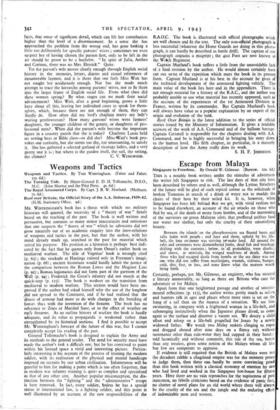Weapons and Tactics
Weapons and Tactics. By Tom Wintringham. (Faber and Faber. ios. 6d.) The Turning Tide. By Major-General E. D. H. Tollemache, D.S.O., M.C. (John Murray and the Pilot Press. as, 6d.) The Royal Armoured Corps. By Capt. J. R. W. Murland. (Methuen. 7s. 6d.) Roof over Britain; the Official Story of the A.A. Defences, 1939-42. (H.M. Stationery Office. gd.)
Mn. WINTRINGHAM'S book has a thesis with which no. military historian will quarrel, the necessity 'of a " theory of war" firmly based on the teaching of the past The book is well written and
persuasive, but contains so many minor inaccuracies and omissions that one suspects the "theory of war" which he advocates did not grow naturally out of an academic enquiry into the inter-relations of weapons and tactics in the past, but that the author, with his mind already made up, searched in the past for material which suited his purpose. His position as a historian is perhaps best indicated by the fact that he quotes only from Oman's earlier book on mediaeval warfare. The title of Vegetius' book is wrongly cited (p. 63) ; the stockade at Hstings existed only in Freeman's imagi nation (p. 6); ancient historians would hardly 'admit the justice of the coMparison between the Roman Limes and the Maginot Line
(p. 92) ; Roman legionaries did not form part of the garrison of the Wall (p. 94) ; Frederick the Great's infantry did not march at the quick-step (p. 123). The book is weakest on the transition, from mediaeval to modern warfare. This section 'would have been improved if the author had asked himself why the use of the longbow did not spread to the Continent, and if he had realised that the -disuse of armour had more to do with changes in the breeding of horses than with the invention of the firearm. The book has no reference to Zisca or Marshal Saxe, or to the effect of weather on earljr firearms. As an outline history of warfare the book is hardly adequate, and its value as propaganda is weakened rather than ,strengthened by its historical sections. I find it possible to accept Mr. Wintringham's forecast of the future of this war, but I cannot completely accept his reading of the past.
General Tollemache's book is designed to explain the Army and
its methods to the general reader. The need for security must have made the author's task a difficult one, but he has contrived to paint within his limited space a vivid and interesting picture. Particu larly interesting is his account of the process of training the modern soldier, with its realisation of the physical and mental handicaps imposed on recruits by our urban civilisation. Infantrymen will be grateful to him for making a point which is too often forgotten, that in modern war infantry training is quitr as complex and specialised as that of any other arm. Another popular misconception, the distinction between the " fighting " and the " administrative " troops is here removed. In fact, every soldier, hitless he has a special status ir international law, is a fighting soldier, and this point is well illustrated by an account of the new responsibilities of the RIA.O.C. The book is illustrated with• official photographs which are well chosen and fit the text. The only non-atheist/ photograph it less successful (whatever the Home Guards are doing in this photograph, it can hardly be described as battle drill). The caption of one photograph corAtain.s a misprint; the 41st Foot are now known as the Weich Regiment.
• Captain Murland's book suffers a little from the unavoidable lack of,a final revision by the author. He would almost certainly have cut out so-ne of the repetition which mars the book in its present, form. Captain Murland is at his best in the account he gives of the technical development of the armoured fighting vehicle. The. main value of the book lies here and in the appendices. There is not enough material for a history of the RA.C., and the author was probably unable to use what material has recently appeared, such se the account of the experiences of the ist Armoured Division in France, written by its commander. But Captain Murland's book; will always have value as a popular explanation by an expert of the origin and evolution of the tank.
Roof Over Britnin is thelatest addition to the series of official stories issued by, the Ministry of Information. It gives a readable account-of the work of A.A.Command and of the balloon barrage. Captain Cotterell is responsible for the chapters dealing with A.A. Command, and he is highly successful in bringing his story down to the human level. His fifth chapter,,in particular, is a masterly description of how the Army really does its work.
• S. H. F. JOHNSTON.






















 Previous page
Previous page